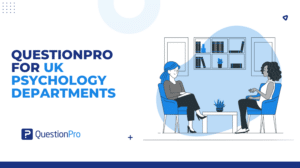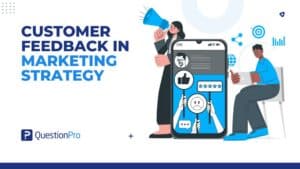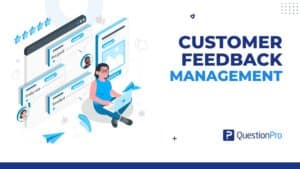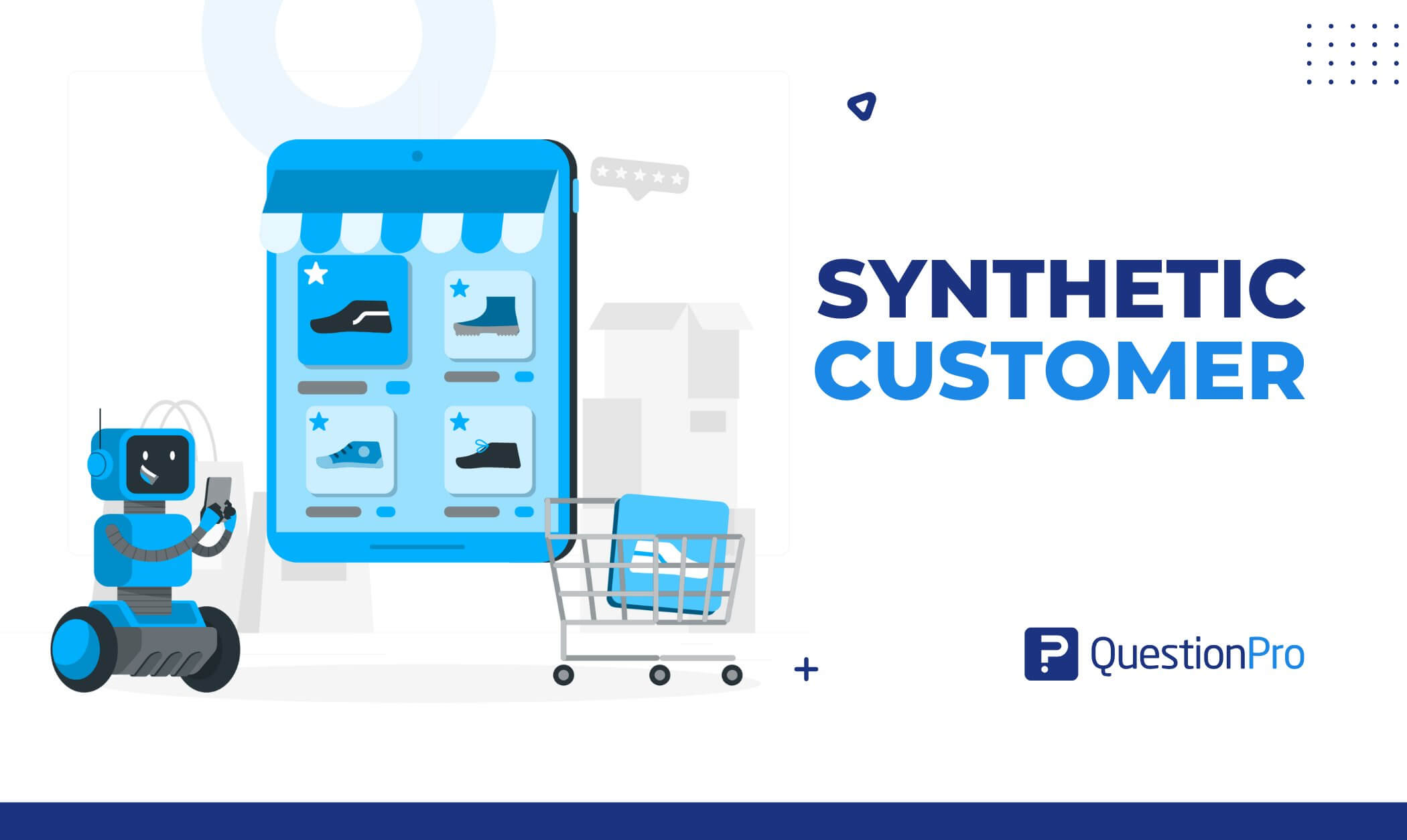
Testing new ideas and improving the customer experience can be challenging and expensive. What if you could create customer profiles that help you simulate real-world reactions before launching your product or campaign? A synthetic customer makes this possible.
Synthetic customers are created using data, AI, and computer simulations to behave like real people when they shop, ask questions, or use a service.
In this blog, we’ll explain synthetic customers, how they can transform your business approach, and the many benefits they provide for testing and refining your strategies.
What is a Synthetic Customer?
A synthetic customer is a computer-created version of a real customer. Instead of using real people and their personal information, businesses use new and evolving technology to build fake customers that behave and make decisions like real ones.
Businesses use synthetic customers to understand how people might react to new products, services, or marketing campaigns without always relying on real customer data. This is helpful because real customer data can be hard to collect, expensive, or have privacy risks. With synthetic consumers, companies can safely experiment and learn without putting anyone’s personal information at risk.
The cool part is that synthetic customers can be made to represent various people. You can create customers of:
- Different ages
- Backgrounds
- Shopping styles and
- Personalities
This helps businesses make sure they aren’t just designing for one type of person but are thinking about a broader, more diverse audience.
Synthetic customers are smart, safe, and a fast way for businesses to study human behavior, improve their products, and create better experiences, all without having to wait for real-world feedback every time.
Learn More: What is A Synthetic Dataset?
What are the Benefits of Using Synthetic Customers?
When businesses want to understand how their products or services will perform in the real world, they often turn to synthetic customers. These are digital, simulated personas designed to behave like real customers. Here’s why many companies are embracing them:
- Saves Time and Money: Testing with synthetic customers is fast and affordable. Unlike real-world testing, businesses can quickly run tests and gather insights, saving both time and money.
- Predicts Customer Reactions: Synthetic customers help businesses anticipate how real customers might respond to products, ads, or services. This allows for strategic adjustments before launching to the public.
- Endless Testing Opportunities: Businesses can create diverse customer profiles (e.g., age, gender, interests) to test different scenarios, providing valuable insights across various demographics.
- Reduces Risks in Product Launches: Synthetic customers allow companies to test products and services before launch. Simulating various scenarios helps identify potential issues, reducing risks when going live.
- Bring More Diversity to Testing: Synthetic consumers can represent people from various ages, backgrounds, and locations, ensuring a more inclusive and well-rounded approach to testing.
Learn More: Synthetic Data Generation Tools & Platforms.
How do Synthetic Customers Work?
In research, synthetic customers are digital models created to simulate the consumer behavior of real customers. They help researchers gather insights and test ideas without needing to involve actual people.
They are perfect for testing new marketing campaigns, product features, customer service initiatives, customer service interactions, and predicting customer churn. Here’s how they work in the world of market research:
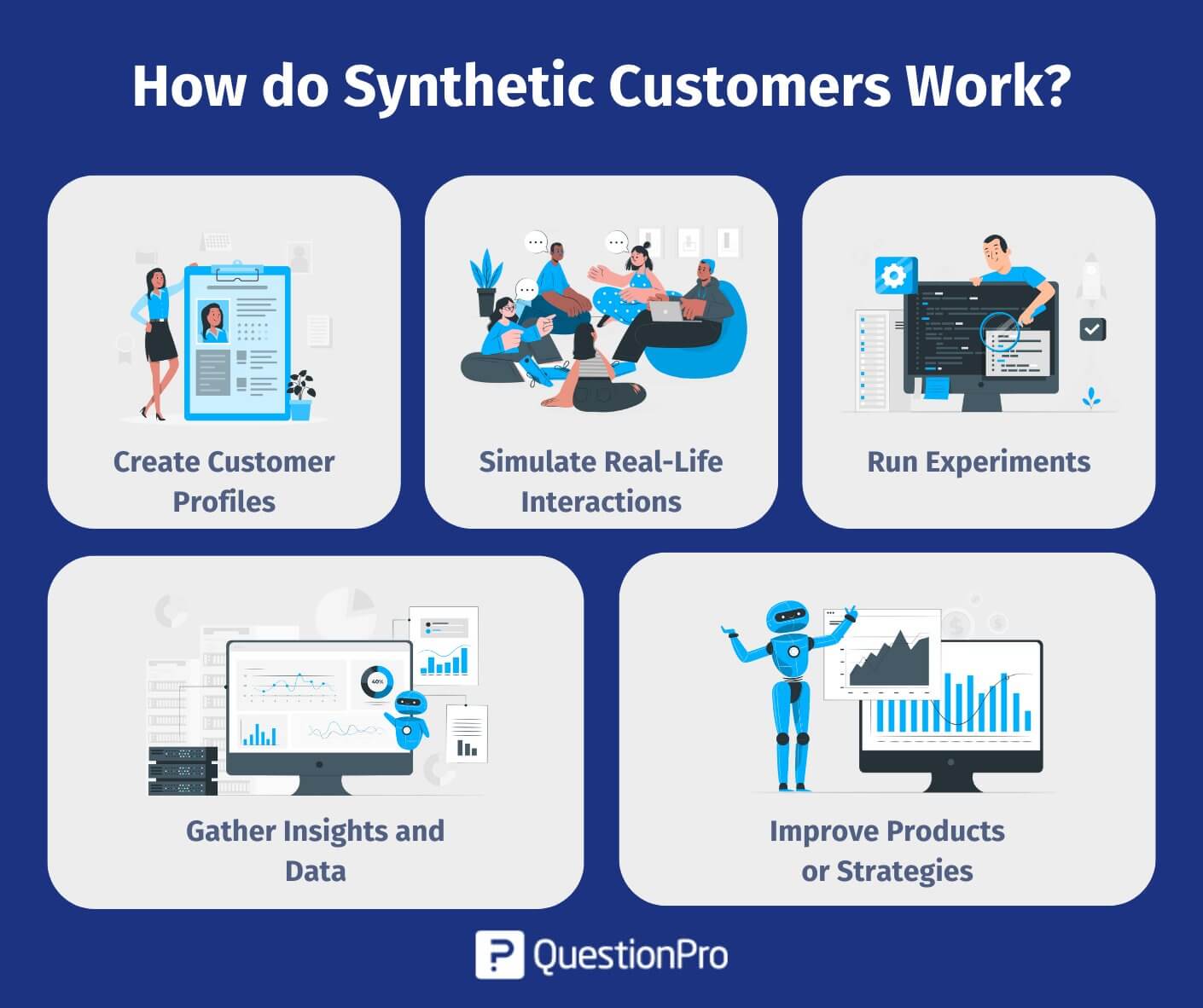
1. Create Customer Profiles
First, researchers use data to create profiles for synthetic customers. This data can come from:
- Past studies
- Surveys or
- General market trends
The profiles are designed to reflect different types of people based on factors like age, interests, income, and buying habits. Think of them as fictional customers who behave in realistic ways.
2. Simulate Real-Life Interactions
Once the profiles are set, synthetic customers are used to simulate real-life scenarios.
For example, a researcher might test how different customer profiles would respond to an advertisement, a new product, or a website. These customers are programmed to act in ways that mimic actual customers, so their responses give researchers a good idea of how real people might react.
3. Run Experiments
In synthetic customer research, customers are used in experiments to test various ideas. Researchers might create synthetic customers to interact with different versions of a product, such as one with a different color or feature.
By tracking how these customers behave, researchers can see which version is more popular and make decisions accordingly.
4. Gather Insights and Data
After running these experiments, researchers gathered data on how synthetic consumers interacted with the product or service. This can include details like:
- How likely they were to purchase
- What features did they like or dislike, and
- How did they react to different marketing tactics
These insights help researchers understand customer preferences, market trends, and potential issues.
5. Improve Products or Strategies
Based on the insights from synthetic customers, researchers can refine products, services, or strategies. This allows businesses to make better decisions and reduce the risks of failure in the market.
Synthetic customers make the user research process faster, cheaper, and safer, as businesses can test ideas without needing to involve actual customers at every step.
Learn More: The Impact Of Synthetic Data On Modern Research.
How to Create Synthetic Customers?
Creating synthetic customers involves creating digital profiles that act like real people. These digital models help businesses test products and ideas without using actual customers.
Synthetic customers make it simple to imitate and predict customer behavior. Here’s how to create numerous synthetic customers step by step:
1. Start with Real Customer Data
To create synthetic customers, you first need real data about actual customers. This can come from surveys, sales data, feedback, or customer reviews. You want to know things like:
- Who are your customers? ( Age, gender, and location )
- What do they buy? ( Their habits, interests, and what products they prefer )
- What do they care about? Their values or motivations (e.g., price, data quality, eco-friendliness).
This synthetic data will serve as the foundation for creating realistic synthetic users.
2. Group Customers into Categories
Once you have the data, the next step is to categorize customers into distinct segments. For example, some customers might be:
- Price-conscious shoppers who love discounts and deals.
- Tech enthusiasts are always looking for the latest gadgets.
- Eco-conscious buyers who prefer sustainable and environmentally friendly products.
Each group will have its own behaviors, preferences, and needs, which you can use to create different types of synthetic customers.
3. Build Customer Profiles
Now that you have segments, it’s time to create detailed customer profiles. A profile is a fictional customer that represents a particular segment.
Each synthetic customer profile should include:
- Demographics: Age, gender, income, location.
- Psychographics: Interests, lifestyle, values, and motivations.
- Buying behavior: How they shop, what influences their decisions, and when they make purchases.
4. Simulate Customer Behavior
Once the profiles are set, the next step is to program how these synthetic customers behave. You can simulate how they would act in different situations.
5. Test Ideas and Gather Data
Now that your synthetic customers are ready, you can use them in tests. For example, you might:
- Test products: See how synthetic customers react to a new product design.
- Run marketing campaigns: Try different ads to see which ones appeal most to each customer profile.
- Simulate shopping experiences: Test how easily customers can navigate a website or purchase a product.
The goal is to gather feedback and data on how these synthetic customers respond to your offering.
6. Refine Based on Results
After testing, you’ll analyze the results from your synthetic customers. What worked? What didn’t? If a product or marketing campaign didn’t respond well to the synthetic customers, you can change it before launching it to real customers.
Learn More: Techniques of Synthetic Data Generation.
Different Usages of A Synthetic Customer
Synthetic customers are not just a cool idea—they’re also used in many real-world situations to help businesses improve their products, services, and strategies. Here’s how they’re applied:
1. Product Testing
One of the main uses of synthetic customers is testing new products. Before launching a product to real customers, businesses can use synthetic customers to see how people might react.
2. Marketing Campaign Testing
Marketing campaigns cost a lot of money and effort. Businesses use synthetic customers to test different marketing strategies instead of running ads on real platforms and hoping for the best. They can see how different customer profiles react to various messages, promotions, or channels before going live with a campaign.
3. Customer Experience Optimization
With synthetic customers, companies can test how easy or hard it is to navigate a website, use a mobile app, or go through the checkout process.
By doing this, businesses can identify issues like confusing navigation or slow load times and make improvements before real customers notice them.
4. Sales Forecasting
Synthetic customers help businesses predict how much they might sell in the future. Companies can estimate how many people will buy by simulating how different customer segments would respond to pricing, promotions, or products. This forecasting helps companies plan their inventory, production, and marketing budgets more effectively.
5. Market Research
Synthetic customers are great for market research because they can mimic the behavior of large groups of real people. Researchers use them to gather insights into customer preferences, buying patterns, and even human emotions. This allows businesses to understand better their target audience and what motivates them.
6. A/B Testing
A/B testing is a popular method for comparing two versions of a product, service, or marketing campaign. Businesses can run A/B tests on different designs, ads, or features with synthetic customers to see which performs better. This is especially useful for testing changes to websites or apps.
Learn More: Synthetic Data Use Cases.
Conclusion
We’ve learned that a synthetic customer allows businesses to simulate real-world customer behavior without the costs and risks of traditional research methods. Businesses can quickly test products, strategies, and customer experiences by creating virtual profiles.
While they offer benefits like cost savings and faster insights, synthetic customers can’t fully replicate the unpredictability of real human behavior. When used effectively, they can improve decision-making and keep businesses competitive.
QuestionPro helps businesses gather insights from both real and simulated profiles. While synthetic customers aren’t a built-in feature, companies can use QuestionPro’s survey tools to simulate real customer behavior by targeting specific demographics.
Its advanced analytics enable businesses to refine strategies and enhance customer experiences.
Frequently Asked Questions (FAQs)
Answer: Companies use them to save time and money. They can test products, ads, and services without taking big risks.
Answer: Synthetic customers are useful in product testing, marketing strategy development, customer service training, AI and machine learning, and predicting customer churn.
Answer: They can be very accurate if built with good quality data and strong models. However, businesses still need to verify their results with real customer feedback.
Answer: They are built using real data, AI, and computer programs. They behave like real customers when shopping, asking questions, or using a service.
Answer: Synthetic customers are commonly used in retail, marketing, technology, and customer service industries to predict customer behavior and improve decision-making.




